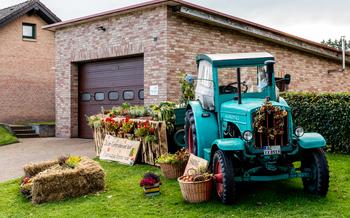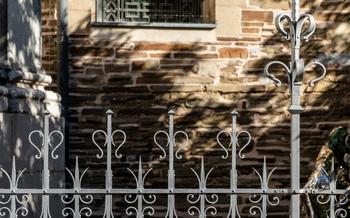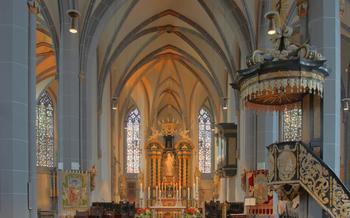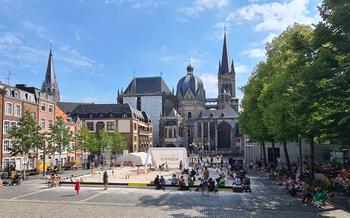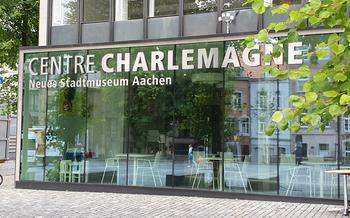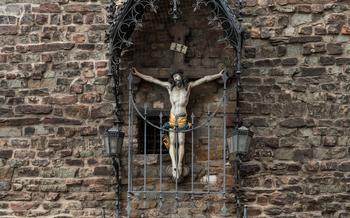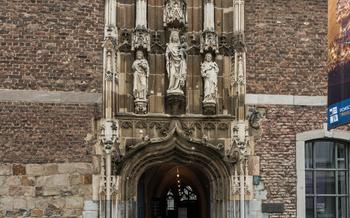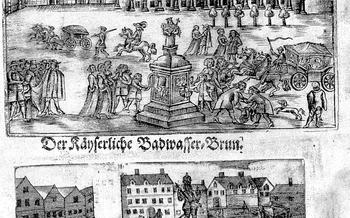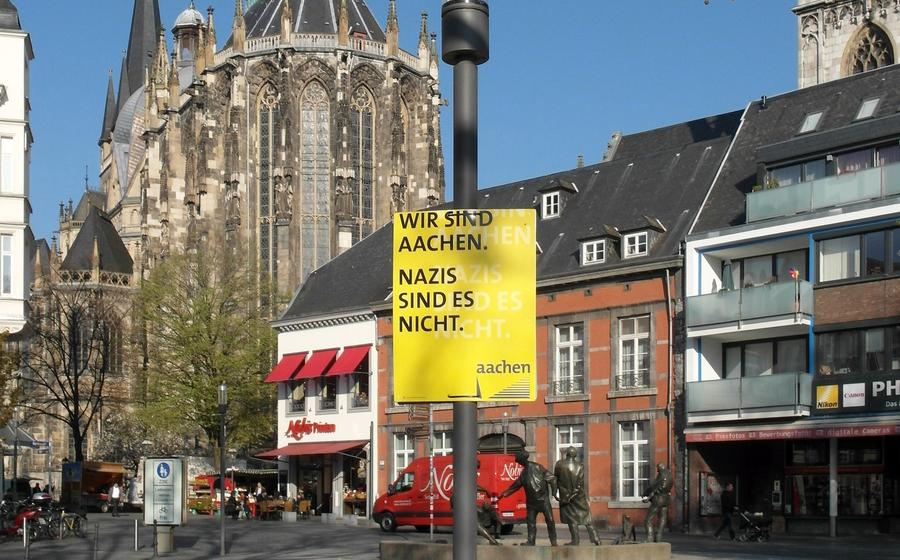
Cemetery of Honour Waldfriedhof Aachen
- Historical Significance
- Honoring the Fallen
- Cemetery Highlights
- Historical Context
- Educational Opportunities
- Paying Respects
- Respecting the Peace
- Transportation Options
- Nearby Attractions:
- Suggested Itineraries:
- Local Customs and Traditions:
- Personal Reflections
- Recommended Reading:
- Insider Tip:
Historical Significance
The Cemetery of Honour Waldfriedhof Aachen, situated in the serene outskirts of Aachen, Germany, holds a profound historical significance. Established in the aftermath of World War I, this hallowed ground serves as the final resting place for thousands of soldiers who valiantly fought and sacrificed their lives during the two world wars. The cemetery's inception can be traced back to the early 1920s when the need arose to create a dignified and respectful memorial for the fallen soldiers. With meticulous care and reverence, the remains of German soldiers were gathered from various battlefields and brought to this tranquil sanctuary. Over time, the cemetery expanded to accommodate the casualties of World War II, transforming it into a poignant symbol of remembrance and reconciliation. Today, the Cemetery of Honour Waldfriedhof Aachen stands as a solemn tribute to the immense sacrifices made by those who fought for their country.
Honoring the Fallen
The Cemetery of Honour Waldfriedhof Aachen serves as a solemn reminder of the sacrifices made by countless individuals during the devastating World Wars. Established to honor the fallen soldiers who bravely fought for their country, the cemetery holds the graves of over 15,000 individuals, including German soldiers, Allied prisoners of war, and civilians who perished during the conflicts.
The graves within the cemetery vary in size and design, reflecting the diverse backgrounds and experiences of those buried there. Some graves bear simple headstones, while others are adorned with elaborate memorials, each telling a unique story of loss and remembrance.
One particularly poignant memorial is that of an unknown soldier, whose grave is marked by a simple cross inscribed with the words "Ein Deutscher Soldat" (A German Soldier). This memorial represents the countless individuals who lost their lives in the wars and whose identities remain unknown, a reminder of the anonymity and tragedy that often accompany conflict.
Other graves in the cemetery are marked with personal effects, such as photographs, medals, or letters, offering visitors a glimpse into the lives of those laid to rest. These personal touches add a poignant dimension to the cemetery, humanizing the statistics and reminding us of the individual stories behind the fallen.
Cemetery Highlights
Among the notable gravesites at the Cemetery of Honour Waldfriedhof Aachen is that of Friedrich August von der Heydte, a German general who played a significant role in World War II. His grave is marked by a simple cross and a plaque bearing his name and rank.
Another prominent figure buried in the cemetery is Walter Model, a field marshal who commanded the German Ninth Army during the Battle of the Bulge. His grave is located near the entrance to the cemetery and features a large black cross with a bronze plaque.
The cemetery also contains several monuments and sculptures that commemorate the fallen soldiers. The most striking monument is the "Pietà", a bronze sculpture depicting Mary holding the body of Jesus. The sculpture is located in the center of the cemetery and serves as a powerful reminder of the suffering and sacrifice of those who died in the wars.
The cemetery's landscaping is simple but effective, with rows of white crosses and headstones set amidst well-maintained lawns and flowerbeds. The natural beauty of the surroundings adds to the peaceful and contemplative atmosphere of the cemetery.
Historical Context
The Cemetery of Honour Waldfriedhof Aachen stands as a solemn testament to the immense human cost of war. Its origins lie in the aftermath of World War I, when the city of Aachen found itself occupied by Allied forces. Among the many challenges faced by the city was the need to provide a dignified resting place for the fallen soldiers who had lost their lives in the conflict.
The establishment of the Cemetery of Honour Waldfriedhof Aachen in 1920 was a direct response to this need. Initially, the cemetery served as the final resting place for German soldiers who had died during the war. However, in the years that followed, it was expanded to include the remains of soldiers from other nations who had also lost their lives in the conflict.
During World War II, Aachen once again became a strategic target, and the city suffered extensive damage. The cemetery itself was not spared from the ravages of war, and many of the graves were destroyed. After the war, the cemetery was meticulously restored, and the remains of those who had been killed in World War II were also interred there.
Today, the Cemetery of Honour Waldfriedhof Aachen serves as a poignant reminder of the human toll of war and the importance of reconciliation. It stands as a symbol of peace and remembrance, inviting visitors to reflect on the sacrifices made by those who fought and died in both World Wars.
Educational Opportunities
The Cemetery of Honour Waldfriedhof Aachen offers a wealth of educational opportunities for visitors interested in delving deeper into the history of World Wars I and II and their impact on Germany. Guided tours are available, providing expert insights into the cemetery's significance, the lives of those buried there, and the historical context of the wars. These tours are an excellent way to learn about the sacrifices made by soldiers and civilians during these tumultuous periods.
Additionally, the cemetery features historical exhibitions and displays that provide visitors with a comprehensive understanding of the events that led to the wars and their aftermath. These exhibitions often showcase artifacts, documents, and photographs that bring the past to life and help visitors connect with the stories of those who lived through these challenging times. The cemetery serves as a powerful educational tool, offering a unique opportunity for students, history enthusiasts, and the general public to engage with the past and gain a deeper appreciation for the sacrifices made during wartime.
Paying Respects
When visiting the Cemetery of Honour Waldfriedhof Aachen, it is essential to observe proper etiquette and customs to maintain a respectful atmosphere. Visitors should approach the cemetery with a sense of reverence and solemnity, mindful of the sacred ground they are treading. Loud noises, boisterous behavior, and running should be avoided, as they can disturb the peace and tranquility of the memorial site.
Upon entering the cemetery, visitors may notice the tradition of laying wreaths or flowers on the graves of the fallen soldiers. This act serves as a poignant reminder of the sacrifices made by these individuals and their families. Visitors are welcome to participate in this tradition by bringing their own flowers or wreaths to lay on the graves.
Moments of silence are encouraged throughout the cemetery, allowing visitors to reflect on the lives and sacrifices of those buried there. These moments of contemplation provide an opportunity for visitors to connect with the past and pay their respects to the fallen.
Respecting the Peace
Amidst the solemn atmosphere of the Cemetery of Honour Waldfriedhof Aachen, it is essential to uphold an environment of tranquility and respect. Visitors are kindly requested to maintain a subdued tone of voice and refrain from engaging in disruptive activities that may disturb the serenity of this sacred space. While capturing the beauty and significance of the cemetery through photography is encouraged, visitors are advised to be mindful of their surroundings and avoid taking intrusive or disrespectful photographs. The cemetery serves as a place of remembrance and reflection, and it is crucial that all visitors contribute to preserving its peaceful and respectful ambiance.
Transportation Options
Public transportation: The Cemetery of Honour Waldfriedhof Aachen is conveniently accessible via public transportation. Several bus lines stop within walking distance of the cemetery, including lines 3A, 3B, 13A, and 13B. Visitors can also take the regional train (RE 4) to Aachen-Rothe Erde station, which is a short walk from the cemetery.
Parking facilities: For those arriving by car, there are ample parking spaces available near the cemetery. Visitors will find designated parking areas on Josefskirchstraße, directly adjacent to the cemetery. These parking spaces are free of charge and offer easy access to the cemetery grounds.
Nearby Attractions:
The Cemetery of Honour Waldfriedhof Aachen is conveniently situated near several notable attractions, allowing visitors to combine their visit with a comprehensive exploration of the city. The majestic Aachen Cathedral, a UNESCO World Heritage Site, stands just a short distance away, captivating visitors with its stunning Gothic architecture and rich history. It is widely regarded as one of Germany's most significant cathedrals and a must-see for any traveler.
Another nearby attraction is the Elisenbrunnen, a historical fountain that has become an iconic landmark of Aachen. This elegant fountain, built in the 19th century, is adorned with intricate sculptures and is a popular spot for locals and tourists alike. Visitors can enjoy a refreshing drink from the fountain's mineral-rich waters while admiring its architectural beauty.
For those seeking relaxation and rejuvenation, the renowned Carolus Thermen is just a short walk from the cemetery. This state-of-the-art thermal bath complex offers a variety of pools, saunas, and wellness treatments, providing visitors with an opportunity to unwind and revitalize in a luxurious setting.
Suggested Itineraries:
For a half-day visit, start by exploring the main entrance and the central memorial cross. Take time to read the inscriptions and learn about the significance of the cemetery. Visit the graves of prominent figures and pay your respects. Remember to maintain a respectful and peaceful atmosphere throughout your visit.
For a full-day exploration, begin with a guided tour to gain insights into the cemetery's history and symbolism. Visit the various sections and pay attention to the different types of graves and memorials. Explore the natural beauty of the cemetery, with its lush greenery and serene atmosphere. Take a moment to reflect and remember the lives lost during the wars. Conclude your visit by paying your respects at the central memorial cross and leaving a flower or wreath in remembrance.
Local Customs and Traditions:
The Cemetery of Honour Waldfriedhof Aachen holds a special place in the hearts of the local community. Remembrance ceremonies and memorial events are held throughout the year to honor the fallen soldiers and their families. On Volkstrauertag, the German national day of mourning, wreaths are laid at the graves, and a solemn ceremony is held to commemorate the victims of war. Special memorial services are also organized on the anniversaries of significant battles or historical events related to the wars. These events provide an opportunity for the community to come together, remember their loved ones, and reflect on the importance of peace and reconciliation. Visitors are welcome to attend these ceremonies and observe the local customs and traditions associated with remembrance.
Personal Reflections
My visit to the Cemetery of Honour Waldfriedhof Aachen was a deeply moving and humbling experience. As I walked among the rows of white crosses, each representing a life lost in the horrors of war, I felt a profound sense of gratitude for the sacrifices made by these brave individuals. The serene atmosphere of the cemetery, with its beautifully landscaped gardens and tranquil surroundings, created a space for reflection and remembrance.
Standing before the graves of young soldiers who had given their lives in the prime of their youth, I couldn't help but be struck by the futility of war. Their stories, etched in stone, spoke of lives cut short, dreams unfulfilled, and families left to grieve. Their sacrifice served as a stark reminder of the devastating consequences of conflict and the importance of working towards peace and reconciliation.
As I left the cemetery, I carried with me a renewed appreciation for the fragility of life and the importance of cherishing every moment. The memory of those who had fallen would forever be etched in my mind, reminding me of the sacrifices made by countless others throughout history.
Recommended Reading:
To delve deeper into the history and significance of the Cemetery of Honour Waldfriedhof Aachen, I recommend exploring the following resources:
-
"Aachen's Waldfriedhof: A Place of Remembrance and Reconciliation" by Dr. Hans-Peter Müller offers a comprehensive overview of the cemetery's establishment, design, and symbolism.
-
"The Fallen of World War I: A Register of the Graves at Waldfriedhof Aachen" provides a detailed listing of the soldiers buried in the cemetery, along with their personal information and military service records.
-
"Honoring the Fallen: The Waldfriedhof Aachen and its Role in Post-War Reconciliation" by Prof. Maria Schmidt explores the cemetery's role in promoting peace and understanding between Germany and its neighboring countries after the World Wars.
These resources offer valuable insights into the historical context, design principles, and cultural significance of the Cemetery of Honour Waldfriedhof Aachen, enhancing your understanding and appreciation of this poignant memorial.
Insider Tip:
For a truly immersive and tranquil experience, plan your visit to the Cemetery of Honour Waldfriedhof Aachen early in the morning. As the sun casts its golden rays through the trees, the atmosphere becomes serene and peaceful. The early hours offer a sense of solitude, allowing you to connect deeply with the solemn beauty of the surroundings. Moreover, the soft morning light casts a unique glow on the graves and memorials, creating a picturesque landscape that enhances the contemplative nature of your visit. Embrace the tranquility of the morning hours to fully appreciate the profound significance of this sacred memorial.


